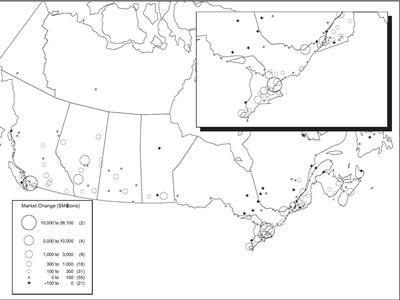
The Changing Pattern of Commercial Specialization: 1991-2001
By Jim Simmons
Over time the Canadian market evolves spatially. Some cities grow, while others decline. The sectoral composition of the economy shifts away from the primary sectors and manufacturing into a variety of services that have different location requirements. Immigrants flock into the largest cities; smaller centres lose population. Big cities absorb neighouring communities. Retirement centres attract the growing number of senior citizens. These changes in the geography of the market require parallel adjustments in the spatial distribution of activities that serve the market: wholesale and retail firms; and financial, business, consumer and public services.
This paper traces the changes that have taken place in location of service activities among the cities of Canada during the decade 1991 to 2001. It builds on a previous CSCA paper based on the 1996 Census by Sommons, Jones and Bylov, and draws on recent papers by Simmons and Bourne that discuss changes in the Canadian market, as described by the 140 urban centres. Perhaps the most important theme, however, is the exploration of the location preferences of an explosion of new service activity that has swept across Canada during the last twenty years. Since 1991, some 78 per cent of the country's employment growth has occurred in services. By the year 2003, there were 1.7 million jobs in communications and business services, and other 1.6 million in consumer services -- in total, more than the primary and manufacturing sectors combined. Economic geography is turned upside down when activities that are oriented to markets and consumers drive the growth. Where do these new services activities locate? Are their clients local, regional or national? How far from the clients should the service be? Which distribution and service centres appear to be the most attractive? This paper examines the directions of growth and relocation during the last decade.
